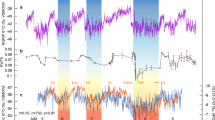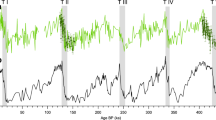Abstract
From 20 to 15 million years (Myr) ago, a period of global warmth reversed the previous ice growth on Antarctica, leading to the retreat of the West Antarctic Ice Sheet and the contraction of the East Antarctic Ice Sheet1,2. Pollen recovered from the Antarctic shelf indicates the presence of substantial vegetation on the margins of Antarctica 15.7 Myr ago3. However, the hydrologic regime that supported this vegetation is unclear. Here we combine leaf-wax hydrogen isotopes and pollen assemblages from Ross Sea sediments with model simulations to reconstruct vegetation, precipitation and temperature in Antarctica during the middle Miocene. Average leaf-wax stable hydrogen isotope (δD) values from 20 to 15.5 Myr ago translate to average δD values of −50‰ for precipitation at the margins of Antarctica, higher than modern values. We find that vegetation persisted from 20 to 15.5 Myr ago, with peak expansions 16.4 and 15.7 Myr ago coinciding with peak global warmth4 and vegetation growth5. Our model experiments are consistent with a local moisture source in the Southern Ocean6. Combining proxy measurements with climate simulations, we conclude that summer temperatures were about 11 °C warmer than today, and that there was a substantial increase in moisture delivery to the Antarctic coast.
This is a preview of subscription content, access via your institution
Access options
Subscribe to this journal
Receive 12 print issues and online access
$259.00 per year
only $21.58 per issue
Buy this article
- Purchase on Springer Link
- Instant access to full article PDF
Prices may be subject to local taxes which are calculated during checkout



Similar content being viewed by others
References
Billups, K. & Schrag, D. P. Paleotemperatures and ice volume of the past 27 Myr revisited with paired Mg/Ca and O-18/O-16 measurements on benthic foraminifera. Paleoceanography 17, 1003 (2002).
Shevenell, A. E., Kennett, J. P. & Lea, D. W. Middle Miocene ice sheet dynamics, deep-sea temperatures, and carbon cycling: A Southern Ocean perspective. Geochem. Geophys. Geosy. 9, Q02006 (2008).
Warny, S. et al. Palynomorphs from a sediment core reveal a sudden remarkably warm Antarctica during the middle Miocene. Geology 37, 955–958 (2009).
Zachos, J. C., Pagani, M., Sloan, L., Thomas, E. & Billups, K. Trends, rhythms and aberrations in global climate 65 Myr to present. Science 292, 686–692 (2001).
Diester-Haass, L. et al. Mid-Miocene paleoproductivity in the Atlantic Ocean and implications for the global carbon cycle. Paleoceanography 24, PA1209 (2009).
Lee, J. E., Fung, I., DePaolo, D. J. & Otto-Bliesner, B. Water isotopes during the last glacial maximum: New general circulation model calculations. J. Geophys. Res. 113, D19109 (2008).
You, Y., Huber, M., Muller, R. D., Poulsen, C. J. & Ribbe, J. Simulation of the middle miocene climate optimum. Geophys. Res. Lett. 36, L04702 (2009).
Beerling, D. J. & Royer, D. L. Convergent Cenozoic CO2 history. Nature Geosci. 4, 418–420 (2011).
Pagani, M. et al. The role of carbon dioxide during the onset of Antarctic glaciation. Science 334, 1261–1264 (2011).
Rignot, E. et al. Recent Antarctic ice mass loss from radar interferometry and regional climate modelling. Nature Geosci. 1, 106–110 (2008).
Anderson, J. B. et al. Progressive Cenozoic cooling and the demise of Antarctica’s last refugium. Proc. Natl Acad. Sci. USA 108, 11356–11360 (2011).
Florindo, F., Harwood, D. M. & Levy, R. H. Introduction to Cenozoic Antarctic glacial history. Global Planet. Change 69 V-VII, http://dx.doi.org/10.1016/j.gloplacha.2009.11.001 (2009).
Masson-Delmotte, V. et al. A review of Antarctic surface snow isotopic composition: Observations, atmospheric circulation, and isotopic modeling. J. Clim. 21, 3359–3387 (2008).
Dansgaard, W. Stable isotopes in precipitation. Tellus 16, 436–468 (1964).
Petit, J. R. et al. Climate and atmospheric history of the past 420,000 years from the Vostok ice core, Antarctica. Nature 399, 429–436 (1999).
Jouzel, J. et al. Orbital and millennial Antarctic climate variability over the past 800,000 years. Science 317, 793–796 (2007).
Sugden, D. E. et al. Preservation of Miocene glacier ice in East Antarctica. Nature 376, 412–414 (1995).
Sachse, D. et al. Sources of variability in the hydrogen isotopic composition of organic compounds from photosynthetic organisms. Annu. Rev. Earth Planet. Sci. 40, 221–249 (2012).
Pagani, M. et al. Arctic hydrology during global warming at the Palaeocene/Eocene thermal maximum. Nature 442, 671–675 (2006).
Acton, G. et al. and The ANDRILL-SMS Science Team. Palaeomagnetism of the AND-2A Core, ANDRILL Southern McMurdo Sound Project, Antarctica. Terra Ant. 15, 191–208 (2008–2009).
Lewis, A. R., Marchant, D. R., Ashworth, A. C., Hemming, S. R. & Machlus, M. L. Major middle Miocene global climate change: Evidence from East Antarctica and the Transantarctic Mountains. Geol. Soc. Am. Bull. 119, 1449–1461 (2007).
Yang, H. et al. Carbon and hydrogen isotope fractionation under continuous light: Implications for paleoenvironmental interpretations of the High Arctic during Paleogene warming. Oecologia 160, 461–470 (2009).
Yang, H., Liu, W., Leng, Q., Hren, M. T. & Pagani, M. Variation in n-alkane [delta]D values from terrestrial plants at high latitude: Implications for paleoclimate reconstruction. Org. Geochem. 42, 283–288 (2011).
Jahren, A. H., Byrne, M. C., Graham, H. V., Sternberg, L. S. L. & Summons, R. E. The environmental water of the middle Eocene Arctic: Evidence from δD, δ O-18 and δ C-13 within specific compounds. Paleogeogr. Paleoclimatol. Paleoecol. 271, 96–103 (2009).
Jouzel, J., Hoffmann, G., Koster, R. D. & Masson, V. Water isotopes in precipitation: Data/model comparison for present-day and past climates. Quat. Sci. Rev. 19, 363–379 (2000).
Frierson, D. M. W., Held, I. M. & Zurita-Gotor, P. A gray-radiation aquaplanet moist GCM. Part I: Static stability and eddy scale. J. Atmos. Sci. 63, 2548–2566 (2006).
O’Gorman, P. A. & Schneider, T. The hydrological cycle over a wide range of climates simulated with an idealized GCM. J. Clim. 21, 3815–3832 (2008).
Sluijs, A. et al. Subtropical arctic ocean temperatures during the Palaeocene/Eocene thermal maximum. Nature 441, 610–613 (2006).
Lewis, A. R. et al. Mid-Miocene cooling and the extinction of tundra in continental Antarctica. Proc. Natl Acad. Sci. USA 105, 10676–10680 (2008).
Tierney, J. E. et al. Northern hemisphere controls on tropical southeast African climate during the past 60,000 years. Science 322, 252–255 (2008).
Acknowledgements
This research used samples acquired by the ANDRILL project and provided by the Antarctic Marine Geology Research Facility at Florida State University. The ANDRILL project is a multinational collaboration involving the Antarctic programmes of Germany, Italy, New Zealand and the USA. The Antarctic Marine Geology Research Facility is sponsored by the US National Science Foundation. Financial support for this research was provided by the US National Science Foundation (ANT-0342484 to D. Harwood and R. Levy, subawards 25-0550-0001-155 to S.J.F. and 25-0550-0001-137 to S.W., ANT-1048343 to S.W. and EAR-090919 to P. Molnar for J-E.L.). This material is based on work supported by the US National Science Foundation under cooperative agreement no. 0342484 through subawards administered and issued by the ANDRILL Science Management Office at the University of Nebraska-Lincoln, as part of the ANDRILL US Science Support program. Any opinions, findings, and conclusions or recommendations expressed in this material are those of the authors and do not necessarily reflect the views of the US National Science Foundation.. We acknowledge laboratory assistance from M. Rincon, M. Cheetham, Z. Zhang and L. Foersterling and discussions with D. Harwood, A. Tripati, A. Kahmen, J. West,J. Tierney, P. Bart, R. Askin, H. Bao, A. Sessions, G. Schmidt and J. Hayes. The simulations were carried out on the Division of Geological and Planetary Sciences’ Dell cluster at the California Institute of Technology, and J-E.L. thanks T. Schneider, T. Merlis, and Z. Tan for their help in incorporating isotopes into GRAM and support by the NASA ROSES Aura Science Team NNH07ZDA001N-AST07-0069.
Author information
Authors and Affiliations
Contributions
S.J.F. conducted the organic geochemistry and δD analyses. S.W. directed the palynology. J-E.L. conducted the model experiments. S.J.F., S.W. and J-E.L. contributed to interpreting the data and writing the paper. All authors contributed to discussions of this work.
Corresponding author
Ethics declarations
Competing interests
The authors declare no competing financial interests.
Supplementary information
Supplementary Information
Supplementary Information (PDF 784 kb)
Rights and permissions
About this article
Cite this article
Feakins, S., Warny, S. & Lee, JE. Hydrologic cycling over Antarctica during the middle Miocene warming. Nature Geosci 5, 557–560 (2012). https://doi.org/10.1038/ngeo1498
Received:
Accepted:
Published:
Issue Date:
DOI: https://doi.org/10.1038/ngeo1498
This article is cited by
-
The response of the hydrological cycle to temperature changes in recent and distant climatic history
Progress in Earth and Planetary Science (2022)
-
Climatic and tectonic drivers of late Oligocene Antarctic ice volume
Nature Geoscience (2022)
-
Hydrological control of river and seawater lithium isotopes
Nature Communications (2022)
-
60 million years of glaciation in the Transantarctic Mountains
Nature Communications (2022)
-
Hydrological impact of Middle Miocene Antarctic ice-free areas coupled to deep ocean temperatures
Nature Geoscience (2021)



